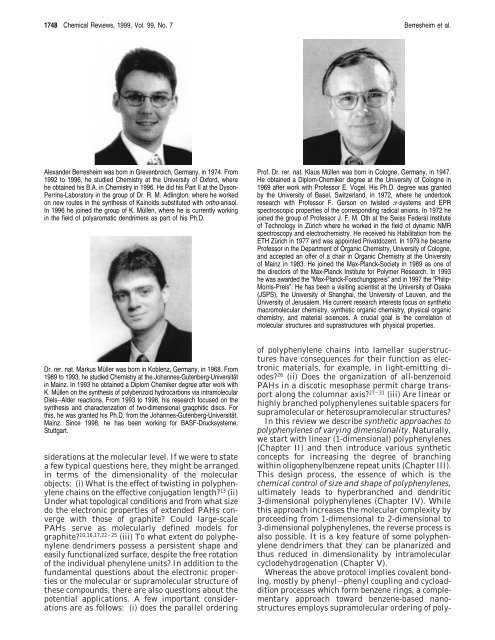Polyphenylene Nanostructures - Cluster for Molecular Chemistry
Polyphenylene Nanostructures - Cluster for Molecular Chemistry
Polyphenylene Nanostructures - Cluster for Molecular Chemistry
You also want an ePaper? Increase the reach of your titles
YUMPU automatically turns print PDFs into web optimized ePapers that Google loves.
1748 Chemical Reviews, 1999, Vol. 99, No. 7 Berresheim et al.<br />
Alexander Berresheim was born in Grevenbroich, Germany, in 1974. From<br />
1992 to 1996, he studied <strong>Chemistry</strong> at the University of Ox<strong>for</strong>d, where<br />
he obtained his B.A. in <strong>Chemistry</strong> in 1996. He did his Part II at the Dyson-<br />
Perrins-Laboratory in the group of Dr. R. M. Adlington, where he worked<br />
on new routes in the synthesis of Kainoids substituted with ortho-anisol.<br />
In 1996 he joined the group of K. Müllen, where he is currently working<br />
in the field of polyaromatic dendrimers as part of his Ph.D.<br />
Dr. rer. nat. Markus Müller was born in Koblenz, Germany, in 1968. From<br />
1989 to 1993, he studied <strong>Chemistry</strong> at the Johannes-Gutenberg-Universität<br />
in Mainz. In 1993 he obtained a Diplom Chemiker degree after work with<br />
K. Müllen on the synthesis of polybenzoid hydrocarbons via intramolecular<br />
Diels−Alder reactions. From 1993 to 1998, his research focused on the<br />
synthesis and characterization of two-dimensional graqphitic discs. For<br />
this, he was granted his Ph.D. from the Johannes-Gutenberg-Universität,<br />
Mainz. Since 1998, he has been working <strong>for</strong> BASF-Drucksysteme,<br />
Stuttgart.<br />
siderations at the molecular level. If we were to state<br />
a few typical questions here, they might be arranged<br />
in terms of the dimensionality of the molecular<br />
objects: (i) What is the effect of twisting in polyphenylene<br />
chains on the effective conjugation length? 13 (ii)<br />
Under what topological conditions and from what size<br />
do the electronic properties of extended PAHs converge<br />
with those of graphite? Could large-scale<br />
PAHs serve as molecularly defined models <strong>for</strong><br />
graphite? 10,16,17,22-25 (iii) To what extent do polyphenylene<br />
dendrimers possess a persistent shape and<br />
easily functionalized surface, despite the free rotation<br />
of the individual phenylene units? In addition to the<br />
fundamental questions about the electronic properties<br />
or the molecular or supramolecular structure of<br />
these compounds, there are also questions about the<br />
potential applications. A few important considerations<br />
are as follows: (i) does the parallel ordering<br />
Prof. Dr. rer. nat. Klaus Müllen was born in Cologne, Germany, in 1947.<br />
He obtained a Diplom-Chemiker degree at the University of Cologne in<br />
1969 after work with Professor E. Vogel. His Ph.D. degree was granted<br />
by the University of Basel, Switzerland, in 1972, where he undertook<br />
research with Professor F. Gerson on twisted π-systems and EPR<br />
spectroscopic properties of the corresponding radical anions. In 1972 he<br />
joined the group of Professor J. F. M. Oth at the Swiss Federal Institute<br />
of Technology in Zürich where he worked in the field of dynamic NMR<br />
spectroscopy and electrochemistry. He received his Habilitation from the<br />
ETH Zürich in 1977 and was appointed Privatdozent. In 1979 he became<br />
Professor in the Department of Organic <strong>Chemistry</strong>, University of Cologne,<br />
and accepted an offer of a chair in Organic <strong>Chemistry</strong> at the University<br />
of Mainz in 1983. He joined the Max-Planck-Society in 1989 as one of<br />
the directors of the Max-Planck Institute <strong>for</strong> Polymer Research. In 1993<br />
he was awarded the “Max-Planck-Forschungspreis” and in 1997 the “Philip-<br />
Morris-Preis”. He has been a visiting scientist at the University of Osaka<br />
(JSPS), the University of Shanghai, the University of Leuven, and the<br />
University of Jerusalem. His current research interests focus on synthetic<br />
macromolecular chemistry, synthetic organic chemistry, physical organic<br />
chemistry, and material sciences. A crucial goal is the correlation of<br />
molecular structures and suprastructures with physical properties.<br />
of polyphenylene chains into lamellar superstructures<br />
have consequences <strong>for</strong> their function as electronic<br />
materials, <strong>for</strong> example, in light-emitting diodes?<br />
26 (ii) Does the organization of all-benzenoid<br />
PAHs in a discotic mesophase permit charge transport<br />
along the columnar axis? 27-31 (iii) Are linear or<br />
highly branched polyphenylenes suitable spacers <strong>for</strong><br />
supramolecular or heterosupramolecular structures?<br />
In this review we describe synthetic approaches to<br />
polyphenylenes of varying dimensionality. Naturally,<br />
we start with linear (1-dimensional) polyphenylenes<br />
(Chapter II) and then introduce various synthetic<br />
concepts <strong>for</strong> increasing the degree of branching<br />
within oligophenylbenzene repeat units (Chapter III).<br />
This design process, the essence of which is the<br />
chemical control of size and shape of polyphenylenes,<br />
ultimately leads to hyperbranched and dendritic<br />
3-dimensional polyphenylenes (Chapter IV). While<br />
this approach increases the molecular complexity by<br />
proceeding from 1-dimensional to 2-dimensional to<br />
3-dimensional polyphenylenes, the reverse process is<br />
also possible. It is a key feature of some polyphenylene<br />
dendrimers that they can be planarized and<br />
thus reduced in dimensionality by intramolecular<br />
cyclodehydrogenation (Chapter V).<br />
Whereas the above protocol implies covalent bonding,<br />
mostly by phenyl-phenyl coupling and cycloaddition<br />
processes which <strong>for</strong>m benzene rings, a complementary<br />
approach toward benzene-based nanostructures<br />
employs supramolecular ordering of poly-

















